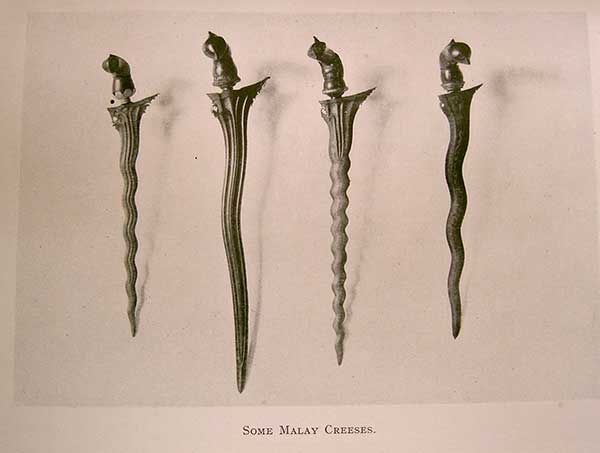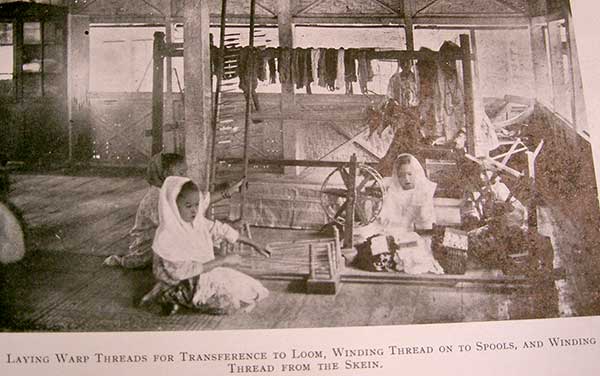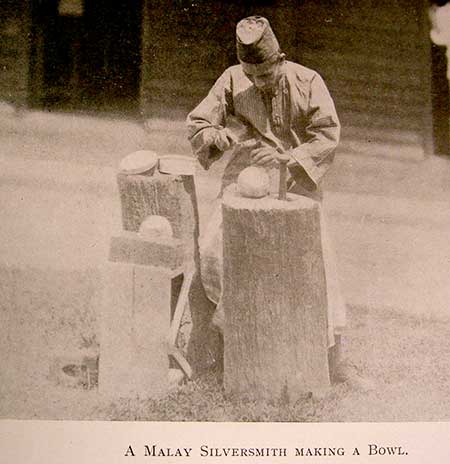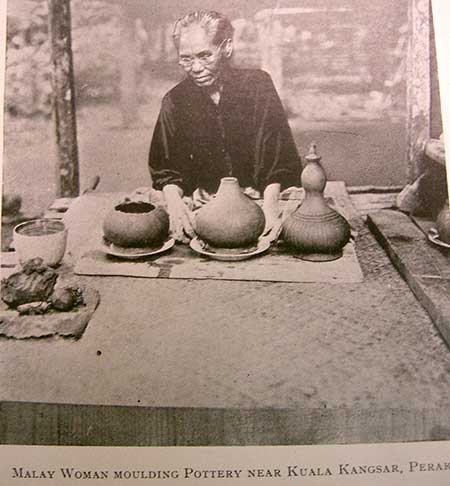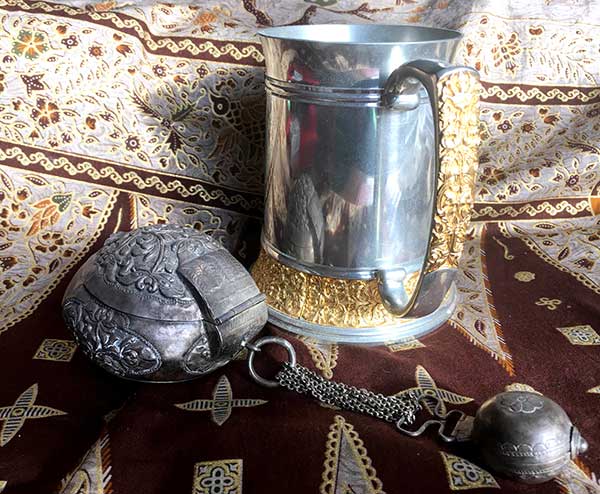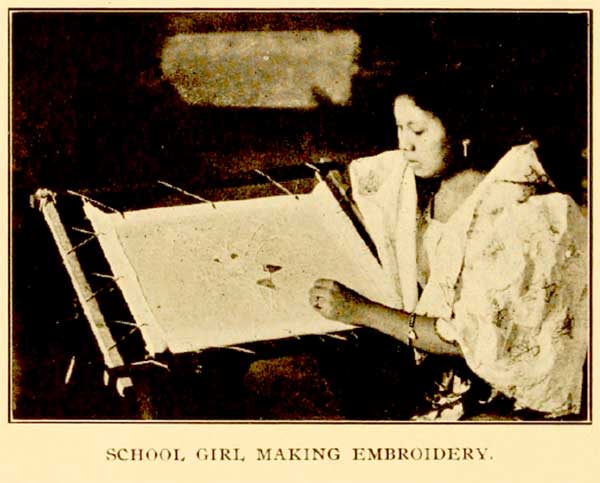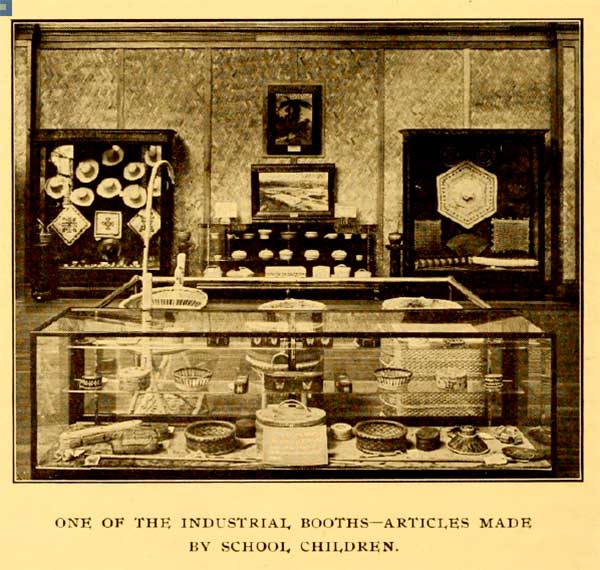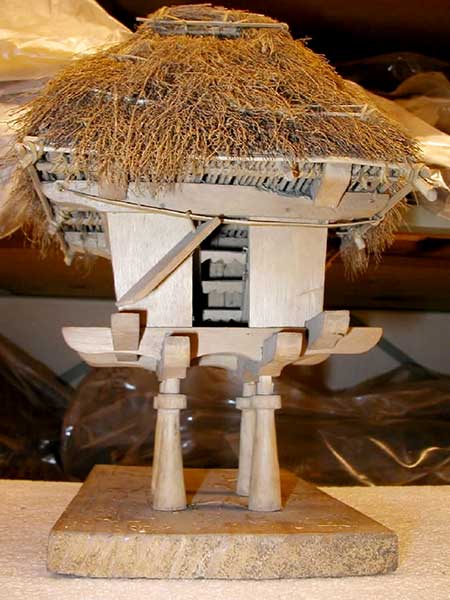FORUM:
Gender and Empire
Imperial Objects: Indigenous Handicrafts, Gender, and Colonial Museums in Modern World History
Matthew Schauer
Introduction
From handicrafts produced in government-sponsored colonial schools to objects collected by Western curators for imperial museums, material culture can provide important insights into the nature of modern global imperialism. Studying the history of an object can give historians a sense of the intimate and mundane life of an object's owner. These objects represent the system of gendered division in which they were created and gendered patterns of consumption and production.1 A single object can even give us an understanding of the social structures relating to social class, racial identity, politics, and economics that affected an individual.
The analysis of these objects can also demonstrate the role of imperialism in the alteration of indigenous cultures and economies, and the reinforcement of imperial systems of political and social power. This article will examine the ways in which handicrafts produced in late nineteenth and early twentieth century Southeast Asia can serve as historical sources that reveal the attempts of colonial administrators to impose imperial conceptions of gender onto indigenous societies. For example, students in colonial Southeast Asia were instructed to produce objects in schools that were meant to convey specific gender-based educational programs. Female students were instructed to produce basketry and textiles, while male students were taught metalwork and agriculture. The objects they produced conveyed gendered ideas concerning imperial perceptions of indigenous traditions, and the items were then exhibited in museums as demonstrations of the level of civilization achieved by each gender within indigenous populations.
The inclusion of a unit on material culture, gender, and imperialism (like the one described below) in an introductory college level modern world history survey gives students an opportunity to connect to the broader implications of imperialism on a global scale. This unit will also allow students to better understand ideas that are central to the study of world history as a whole such as: global networks of knowledge, the implications of the ideas of Western dominance, and effects of conceptions of race, social class, and gender.
Below, the first section will describe the broad historiographical trends that have been used to connect studies of material culture, museums, and Western perceptions of indigenous culture and gender to the field of imperial history. The second section will describe how colonial education, handicrafts production, and imperial museums can be used as examples of the structures, methods, and residual effects of imperial power. The final section will contain descriptions of a syllabus unit and two assignments that can be added to an introductory world history survey. This unit, which is entitled " Objects and Imperial Cultures," conveys to students a general overview of the ways in which imperial nations in the late nineteenth and early twentieth centuries utilized ideas of gender, race, and indigenous culture as tools of imperial control.
The assignments will involve the analysis of indigenous handicrafts and will demonstrate to students how objects of material culture can be used as primary sources within world history courses. The use of gender as an analytical lens in the classroom is an excellent way to touch on the broader importance of these objects within larger patterns of imperial trade, economics, and indigenous traditions. These objects can also connect students to individual experiences of living under imperial control. Through the analysis of a single object such as a basket produced for the Philippine Reservation at the 1904 World's Fair, students will be able to discern how an individual's educational opportunities, economic and social status, cultural traditions, and identity were affected by imperial policies and practices.
Instructing students in the analysis of objects produced within a colonial setting is an excellent way to introduce non-textual sources to students in the world history classroom. The final section includes descriptions of two assignments that require students to complete historical object studies and to create an exhibition on gender, handicrafts, and imperialism in Southeast Asia. Students will be assigned primary sources and secondary articles to encourage them to think critically about the ways in which curators have ascribed meaning to these objects, and the ways in which the collective memory of colonialism has affected the broader history of the region.
Handicrafts and Museums: Material Culture in a Global Imperial Context
The historiography of imperial material culture and museums has grown out of post-colonial studies of imperial cultures and colonial knowledge production. "Imperial culture" in this case can refer to the exported cultural practices of the metropole, such as gentlemen's clubs or local museums, or the way that culture is used as part of a system of imperial control. This can involve the "production of colonial knowledge," which includes but is not limited to imperial ethnology, information collected through surveillance, indigenous histories rewritten and reprinted by colonial presses, and textbooks. Imperial culture also includes the perpetuation of gendered norms and conceptions within popular social practices, political structures, and as will be examined below, educational systems.
These two strands of post-colonial imperial history owe a debt to the legacy of Edward Said's Orientalism, and the work of Bernard Cohn, Nicholas Dirks, and John M. Mackenzie among others.2 From the study of museums and indigenous handicrafts produced in the colonial setting, historians can gain insight into systems of "imperial knowledge production," such as museums and their global connections, global exhibitions, object exchanges, and the trading of handicrafts as a local and global commodity.
Handicrafts were perceived as tangible demonstrations of "cultural traditions." These traditions were seen to be geographically unique and were manifested through an artist's chosen craft, which in some cases were "passed down" along gender lines. Handicrafts tended to be objects that were hand-made using non-industrial processes, and were items that exhibited utility and patterns or materials that made them unique to an indigenous population or region. Even if the item was meant to be decorative, like a rug, piece of pottery, lace, knife etc., these items theoretically could have a daily use. They were not perceived as fine art like a Western oil or Turkish miniature painting, with some exceptions including work in gold or silver. In many ways, colonial ethnologists saw indigenous handicrafts practices as a distillation of the history and present state of indigenous culture and civilization. For example, British ethnologists perceived Malay handicrafts to be a in a state of degeneracy and Malay artisans' inability to be inventive and harness new technology as a hindrance to the progress of the Malay civilization.3
Historians have found ways to problematize these colonial definitions and descriptions of indigenous artworks and handicrafts. These artifacts, their provenance, and history of exhibition, can give us insight into the systems of imperial power that artists were working under and even serve as relics of the experience of colonial occupation. Historians of art Tim Barringer and Tom Flynn have edited a global interdisciplinary collection that examines the role that "power relations of colonialism have [had] on the interpretation of objects," the "effects" of the "importation of objects and materials from the colonies have [had] on artistic production," and the ways in which objects were "appropriated" in the metropole through consumption and museum display.4 This work emphasizes the rippling effects of the production, sale, exhibition, and preservation of objects produced and exhibited in Africa, South Asia, Europe, the United States, Britain, and the Soviet Union.
The analysis of the role of gender in shaping the production, sale, and perception of meaning ascribed to objects of material culture takes several different forms. First, objects were created in the colonies through indigenous systems of labor, in which the artisans were often divided by gender. These systems of labor, many of which were informal, were then recorded, codified, and appropriated within the imperial economic and educational system. For example, lace making was typically thought by British writers to be a "feminine" craft in Malacca, Malaya. Lace making had come to Malacca from European influences (likely Portuguese), was typically done by Malay women, was a staple in "domestic education" curricula for girls in Europe, and was therefore perceived to be a universally feminine skill.
|
|||
| Figure 2: Ivor H. Evans, Malay Arts and Crafts (Singapore: Fraser and Neave Limited Printers, 1923), Plate 2. | |||
Alternatively, goldsmithing and sword making were perceived to be masculine. When these ideas became codified in the vocational education plans of schools in the Philippines and Malaya, this solidified these gendered divisions in colonial society, even if these divisions of labor were not universal across the region. Information on the individual artists who produced these goods is often very difficult to obtain, as much of their work is lost or unsigned, but by exploring the provenance of the objects that still remain, we can uncover some details about the context in which objects were produced and sold.
|
|||
| Figure 3: Silversmithing was seen by British ethnographers as a distinctly masculine craft. Ivor H. Evans, Malay Arts and Crafts (Singapore: Fraser and Neave Limited Printers, 1923), Plate 3. | |||
Object studies and the analysis of handicrafts' form, function, and means of creation in an imperial context have been influenced by the history of art and museum studies. These fields have influenced other recent interdisciplinary work in the global history of imperialism that examine imperial networks relating to museums and objects, such as Sarah Van Beurden's recent work on the politics and representation of Congolese art in Belgium.5 John M. Mackenzie, Sarah Longair, and John McAleer's work has raised important questions about the role of museum curators in the propagation of imperial control and the function of these networks of museum exchange across the British Empire.6 Two of the broad questions arising from these works can be summarized as: "How important were imperial museums and curators as active agents of imperialism?" and "What effects did the collection and exhibition of indigenous cultural objects have on indigenous culture and identity?"
In order for students to effectively understand the wider importance of museums and handicrafts in modern imperialism, it is necessary for them to have an understanding of several complex concepts: Orientalism, knowledge production, ethnology, race, and gender. Many students come into the world history survey with little background in history, much less any of these concepts. At my university, there are no prerequisites for history courses, we lack a formal anthropology department, and a wide scope of world history is often not heavily stressed in secondary education. These potential issues, combined with the fact that students are of varying levels of skill and interest, often make it challenging to make the case that imperialism "matters." It is often then very difficult to demonstrate to them the importance of museums and indigenous handicrafts in imperial cultures. The challenge then is how to effectively convey to them the basic definitions of these complex concepts while not intimidating them, or expecting them to quickly grasp Said and Foucault.
I introduce students to Edward Said's definition of Orientalism through a lecture, a handout, and an assignment, which requires out of class preparation and in-class discussion and writing.7 The concept of "the Other" and the geographic and theoretical distinction between "Orient" and "Occident" usually causes a lot of confusion among the students. My lecture on 19th century India includes a brief introduction on William Jones and nineteenth century Orientalism, in order to give the students some contact with the term. I quickly introduce Said's ideas, so that they get a sense of how Said is in many ways reclaiming this term and problematizing it. I have found that the longer I wait to introduce Said, the greater the difficulty students have with confusing the terms.
I assign students excerpts from popular travel literature and imperial ethnologies, such as excerpts from the writings of Richard Francis Burton, Lady Wortley Montagu, and W.H. Furness. These readings provide them with straightforward examples of "othering" and the fascination with exoticism.8 I build on this in a lecture during the week. The section on Orientalism, culminates with an assignment in which students are responsible for selecting and examining European "Orientalist" paintings from the late nineteenth and early twentieth centuries.9 In the assignment (a version is attached in the Appendix, the students are instructed to analyze the paintings for ideas of "timelessness," with a particular emphasis on ideas of gender, race, and technology. Students generally choose paintings that are loaded with Orientalist imagery, particularly in regards to race and gender. Jean-Léon Gérôme's paintings of harem baths and marketplaces are generally the most popular.10 Through this exercise, students are able to connect a non-textual source, in the form of a painting, to a text, such as nineteenth century "Orientalist" writers.
Students are able to see clear imagery that depicts European conceptions of cultural and technological superiority over non-Europeans. The paintings and excerpts also contain heavily gendered imagery and language ranging from blatant sexual objectification to ideas or images that convey a sense of feminine weakness and demurity. Through these writings and paintings, students are able to understand how an "image" of a society is created through a contemporary source base. They also realize the one-sided nature of Western sources that arose out of an imperial context, and how this demonstrates a "production" of knowledge. Last, they leave with the idea that ideas of gender are part of this "imagination." This then gives them a general precedent for our section on education, handicrafts, and gender, which I detail in the final section of the article.
Gender, Handicrafts, and Ideas of Cultural Preservation and Development in Imperial Education
Imperial education that included instruction in the production of handicrafts was commonplace in colonial settings in the nineteenth and early twentieth centuries. Handicrafts programs were part of larger imperial educational initiatives that aimed to increase indigenous populations' "economic self-sufficiency" with the hope of ultimately leading to rural economic development. Colonial governments aimed to use education to place indigenous peoples on a path where they could ultimately be "responsible" financially and otherwise for their own "uplift." These programs were not limited to handicrafts education but also included technical and vocational training, particularly in agriculture. The knowledge used to develop these programs was typically gathered by imperial ethnologists, both amateur and government-salaried, and generally involved a simplification of preexisting economic systems with the goal of conveying ideas of capitalist "work ethic" to indigenous artisans and laborers. These educational systems were found in numerous colonial settings including British India, the United States, the Netherlands Indies, British Malaya, and the American Philippines.
Many of these imperial ethnologists were also colonial administrators, and were fundamental in shaping education policies in their respective colonies. An example is Sir Richard Winstedt, who was a scholar of Malay history, culture, and language, and was also involved as an advisor and later the Director of Education for the Straits Settlements and the Federated Malay States from 1924 to 1931. Winstedt was instrumental in pushing for the implementation of vocational and domestic education programs that were replicated from programs instituted in the American Philippines and Netherlands Indies. These programs focused on handicrafts education as way to introduced non-industrialized mass-production and capitalist economic systems among Malays living in rural areas, in order to provide them with more income and theoretically to improve their living conditions.11 These policies also focused on women as prime movers in this new economic system that aimed to revitalize lost Malay handicraft traditions, through the commodification and eventual global sale of Malay handicrafts.12
These types of imperial education policies involved distinctly gender-specific educational programs influenced by Western models and imperial ethnology itself. Domestic education programs for girls often included childrearing, cooking, traditional domestic crafts (such as the previously mentioned lace), while education for boys tended to be more focused on creating skilled laborers or, in the case of Malaya, more efficient farmers and fisherman.13 Handicrafts production then served the role as either a supplement to income, as a sort of a cottage industry or, in the cases of the Philippines and Malaya, as a vocation. These programs were to be a shortcut to economic improvement and were supposed to bring about change in the daily lives of those living under colonial rule. New wages from handicraft sales were meant to eliminate the need for colonial governments to pay for programs that improved infrastructure, public health, or brought about improvements in indigenous populations' daily lives.
|
|||
| Figure 4: Malay women traditionally sold handicrafts in the marketplace. British administrators hoped to make their sales increase through new and efficient methods of marketing and production. Ivor H. Evans, Malay Arts and Crafts (Singapore: Fraser and Neave Limited Printers, 1923), Plate 1. | |||
Vocational and handicrafts programs were also justified using the rhetoric of "cultural preservation." Handicrafts instruction in schools would theoretically revitalize traditional handicrafts as a potentially productive industry and also, in the case of Malaya, reinforce Malay cultural traditions. This would then help maintain stability for the existing system of indirect rule, in which the British supported the Malay sultans as nominal rulers of the majority of the colony.
These "traditional skills" which were appropriated and altered by colonial schools were meant to bring about self-sufficiency, but were also an opportunity for colonial governments to attempt to manage their students' sense of cultural identity. Native American boarding schools in the early twentieth century in the United States epitomized this concept. Much like in the Philippines and Malaya, Native American crafts were "taught" in Native American boarding schools and students were encouraged to become skilled in weaving, basketry, and other handicrafts in the first decades of the twentieth century. The idea of inscribing "native" patterns onto consumer goods was a common practice thought to improve sales. For example in 1929 in South Dakota, Native American students put on a "bazaar" to "preserve Indian art in fancy work" through the sale of items like "furniture…made with inlay work in Indian designs."14 In the 1930s, these types of programs were expanded through the policies of Commissioner of Indian Affairs John Collier, who hoped to preserve Native American culture as part of an attempt to uplift Native Americans.
Colonial administrators in the U.S. Philippines and British Malaya attempted to reach out to a broader global market through the mass production of popular patterns and by adapting pre-existing goods to Western tastes. For example, in Malaya, Winstedt urged instructors to adapt Malay designs for silver betel nut and tobacco boxes (like the one pictured) to Western pocket watches.15 The Malays were seen by the British as losing out to Chinese businesses who were much more integrated into Western markets, such as the Royal Selangor Pewter Company, which produced goods for Western expatriates like beer tankards and cigarette boxes.16 Marketability was the driving force behind these educational initiatives, more than any sort of sense of cultural preservation. Winstedt, who was a collector of Malay art, even urged schools to adopt the more marketable patterns from the Philippines that had sold well at the Panama Pacific Exhibition.17
|
|||
| Figure 5: In the attached photo, the Malay silver tobacco and betel nut Box is from the early twentieth century. The tankard was one of Royal Selangor's most popular items made for Western consumers. This example is contemporary. The author's photo and objects from the author's collection. | |||
Global exhibitions and World's Fairs provided an opportunity to create a global market for handicrafts produced in the colonies. Imperial nations exhibited objects from their colonies as a testament to their own economic and political prowess. Indigenous handicrafts were exhibited and sold right next to exhibits demonstrating commodities and agricultural practices as part of the "wealth" of specific colonies. Several large colonial fairs were held in Europe, such as the expositions in Amsterdam in 1883, Paris in 1900, and Brussels in 1910.18 Fairs were also held in the colonies themselves such as fairs in Kuala Lumpur and Java in the early twentieth century. World's Fairs such as those held in the United States in Chicago in 1893 and St. Louis in 1904 also displayed similar colonial exhibits.
|
|||
| Figure 6: Colonial administrators encouraged students to weave from premade patterns in order to aid their objects' marketability. Philippine Islands Bureau of Education, The Philippine Public Schools at the Panama-Pacific International Exposition (San Francisco: Marnell and Company, 1915), 18. | |||
|
|||
| Figure 7: These exhibits showcased the ways that Filipino students utilized new technology in their handicrafts. Philippine Islands Bureau of Education, The Philippine Public Schools at the Panama-Pacific International Exposition (San Francisco: Marnell and Company, 1915), 7. | |||
The artisans themselves were often brought over from the colonies to demonstrate their crafts in person for visitors, and to serve as living testaments to the success of these imperial systems. The Philippine Reservation at the 1904 Louisiana Purchase Exposition allowed visitors to take a walk through a reproduced "Igorot Village" in which the Igorot residents had been instructed to make handicrafts, dance, and feast on dogs in order to entertain guests. At the end of their visit to the Reservation, visitors would emerge into a "modern" Filipino city complete with "civilized" indigenous soldiers and policemen. After the end of the Exposition, the handicraft items and exhibits were sold to American museums, such as the Milwaukee Public Museum and the University of Pennsylvania Museum, serving as the basis for their Philippines collections. The Panama Pacific Exposition continued these trends of imperial propaganda with a distinct emphasis on the success of American schools and their handicrafts training. Handicrafts from the Philippines sold extremely well, and the government even began branding with labels reading "Philippine" in order to cultivate a certain level of authenticity.19
|
|||
| Figure 8: Handicrafts sold very well at the Panama-Pacific Exposition. Note the miniature hats that were created as souvenirs for visitors. Philippine Islands Bureau of Education, The Philippine Public Schools at the Panama-Pacific International Exposition (San Francisco: Marnell and Company, 1915), 20. | |||
Colonial governments were not the only ones to explore the idea of "branding" indigenous handicrafts for marketability and an attempt to insure authenticity. Historian Erika Bsumek has examined how the Navajo people of North America reimagined the "Navaho" label as they negotiated capitalist markets of handicrafts sales.20 These sales led to "cultural production that drove a chain of relationships to produce racialized objects."21 Unlike Malay artisans who were made to work from Filipino patterns, Navajo artisans were active participants in this economic system of consumption and sale of "Indian-made" consumer goods, as they altered their own patterns to encourage marketability.22
These museums, which existed in both the colonies and metropole, collected and exhibited these objects. In some ways, they continued the propagandistic exhibition style of the colonial and World's Fairs, but also instituted new ethnology-based forms of exhibition. These curatorial systems created exhibits that were subtler than the public expositions but still often brought visitors to the same conclusion: that the peoples of the West were culturally, technologically, and racially superior to the peoples of Asia and Africa. Some museums utilized evolutionary systems of organization based on perceptions of technological prowess. For example in the Perak Museum in Malaya, a visitor would have progressed from a case of stone tools to one with iron weapons and agricultural tools. Through the visitor's physical progression thorough the exhibit, this exhibition system demonstrated the difference in levels of "civilization" between the indigenous "Orang Asli," who were described as "prehistoric," and the "semi-civilized" Malays.
Museums also used less overt systems of comparison, such as the Pitt Rivers Museum in Oxford. The Pitt Rivers Museum utilized a "typological" system of display in which objects from all over the world were collected according to their use. For example, the museum (which has preserved the original exhibits) has vitrines with "tobacco pipes" and "knives" from all over the world. Visitors are then left to draw their own conclusions about the level of technological advancement demonstrated by each item.23 This nineteenth century model privileges societies with industrialization, as a factory-made knife would be set apart as being "modern" in comparison to a handmade obsidian knife by being organized with other "modern" steel knives from other Western societies. The same could be said of gendered collections, such as items relating to marital or birth practices in Asia and Africa, which undoubtedly often looked "primitive" to English visitors in the nineteenth century due to their differences to equivalent items in Western societies.
These museums, their curators, and those who donated their collections were involved in the spread of imperialism and the reinforcement of conceptions of Western superiority. As with Malay, Navajo, and Filipino artisans, collectors often drove changes within traditional practices of handicraft production through their desire to collect certain objects as "artifacts" of a civilization in decline or decorative items they found attractive. Indigenous people were not without agency in this system, as they adapted to the forces of the market place, and in some cases even enthusiastically participated in colonial exhibitions.24 Many of these colonial collections and the museums themselves were ultimately taken over by nationalist governments after decolonization, such as the Museum Nasional of Indonesia and the Muzium Negara (National Museum) in Malaysia. This allowed new curators to reshape these collections and exhibitions to fit the newly independent nations and their desires for a cohesive sense of identity. The objects that were created, collected, and exhibited in the colonial era of the late nineteenth and early twentieth centuries then can be seen as having new renegotiated meanings as representations of both imperial and post-colonial history.
Sources on Museums and Handicrafts
In order to analyze objects effectively as historical sources, historians often have to trace these objects' pathways of ownership, or provenance, and the context from which an object was created or exhibited. Historians do this by completing research in archives, museums, and even small private collections. It is important to convey to students the wide variety of sources and research that go into completing the study of a single object. Students will be able to get a sense of this in the Object Study assignment that is in the Appendix.
In terms of primary sources, information directly connected to imperial policy and education can be found in officially printed reports, committee meeting minutes, publications, textbooks, and curricula guides. Imperial governments tended to take meticulous records, which were collated, printed, bound and sent back to repositories and archives in Europe. The Colonial Office Records held in the National Archives in Kew, England, even includes bound copies of job applications, purchase orders, and daily memorandums. Unless one is lucky enough to find administrators who wrote diaries, published their own work, or had their letters preserved due to the fact that they were someone of prominence, this official correspondence is typically the best source for their opinions and ideas. As far as gaining insights into the perspectives of teachers and students, it is much more difficult to find their first person responses to living and working within these systems. One wonderful exception to this is the work of Brenda Child, who has analyzed the boarding school letters of Native American students and teachers who attended or worked at institutions in South Dakota and Kansas.25
The same difficulty exists when trying to gain the perspective of individual artisans who graduated from these schools. This is why it is necessary to analyze the individual components of the system and piece together some semblance of an individual's experience of imperialism. There are Filipino, Malay, and Indonesian language periodicals that begin to be published in the early twentieth century that give a broad sense of the experience of imperialism. Many of these types of sources served as a basis for anti-colonial movements and demonstrate a growing sense of nationalist identity. For example, Majallah Guru was a periodical founded by Malay teachers, in which they aired their grievances and opinions about British educational policies.26
Objects can serve as sources even without much information available about the artisans that created them. By tracing an object's provenance through museum records, many of which were also meticulously kept, printed, and distributed, it might be possible to get a better sense of the individual that created the object.27 For example, if we find that the Milwaukee Public Museum took in an accession of Filipino artifacts, basketry, models, and weapons in 1904 but are unsure of their provenance, we can look back into the museum's collections records and examine the objects themselves to see if they are from the Louisiana Purchase Exhibition in St. Louis. If the objects have telltale tags, or there are records of purchase and we can directly connect them to the Exhibition, we can gain a new understanding of their background. We can surmise that these objects, such as the models, were created to demonstrate Filipino handicrafts to visitors to the Philippine Reservation in St. Louis, and then sold off after the Fair. We can look through images of the fair to see individuals in the village using similar implements as in a way get a sense of what the experience of the Fair might have been like for visitors and Filipinos who were far from home. We can also compare the objects to other items from the Philippines to see how the Fair items were produced to cater to American buyers.28 Analyzing objects can help us retrieve some records from the past, even though clear provenance might not have been recorded or preserved.
|
|||
| Figure 9: Models like these were used to exhibit Filipino handicraft skills and also to serve as objects in the colonial exhibition. Models of fairly mundane items, such as carts and houses were then sold off after the Fair. Author's Photo, Used with Permission of the Milwaukee Public Museum. | |||
"Objects and Imperial Cultures": A Unit on Empire, Gender, and Material Culture for World History Syllabi
The unit "Objects and Imperial Cultures" is meant to build on imperialism as one of the central themes of my Modern World History course. Like the other themes in the course (industrialization and human rights), imperialism serves as a central thread for students as they move from 1500 to the present day. For example, we start with the Spanish and Portuguese empires in North and South America in the first week of the course, and students later are required to assess the differences between the European empires in the "New World" and "Gunpowder Imperialism" in Asia with imperialism in the nineteenth and twentieth centuries. Students will enter this section of the course with a working understanding of imperialism, Orientalism, and definitions of race, social class, and gender.
The unit lasts two weeks and involves assigned excerpts of secondary readings, primary source readings, and an online exhibition. Students will read excerpts from two imperial periodicals. The first periodical examines Malay arts and crafts and was published for the British Empire Exhibition in 1924. Ivor Evans, a colonial museum curator and ethnologist authored the work. Evans clearly stated his beliefs that Malay crafts were degenerating and needed to be saved through the use of educational programs.29 The other excerpt is from a periodical describing the ways in which U.S. sponsored educational programs were exhibited at the Panama-Pacific Exposition in 1915.30 Students use these primary sources to gain firsthand knowledge of the type of rhetoric that was used surrounding handicrafts and colonial education. Students will also be assigned an online exhibition on the 1904 Louisiana Purchase Exposition and a brief excerpt of Marieke Bloembergen's work on European colonial expositions.31 These works will prepare them to think critically about the ways in which gender, imperial propaganda, and racial superiority were publically exhibited. It is the goal of the unit that students will then apply this knowledge to their two essay assignments that focus on the analysis of indigenous handicrafts from colonial Southeast Asia.
Students will listen to lectures on imperial culture, including lectures on "World's Fairs, Colonial Exhibitions, and Museums," the "Victorians, Anthropology and the Exotic," and "Colonial Education and Imperial Power." These lectures will include syntheses of the main theories of Dirks, Mackenzie, and Bernard Cohn, which I have found to be too difficult for introductory classes. The goals of these lectures are to provide background information for students as they approach their two assignments, but also for them to understand the global nature of these ideas of imperial culture and their interactions with broad ideas of race and gender. Students will discern that the fascination with the "exotic" was not just a British or French idea, and they will perceive how these ideas became pervasive in popular and material culture. For example, students will examine inexpensive paisley cloth and contemporary tobacco advertisements in order to see how that middle class consumers "experienced" the British Empire.32 This idea will be built upon during the lecture on World's Fairs and colonial exhibitions, which will serve as a template for the students as they analyze museum exhibitions.
The readings and lectures will lead into two assignments. One of these is a short object study, the goal of which is to get students to think critically about objects as historical sources. The other assignment is to complete small online "exhibition" in which students' are required to make and problematize curatorial choices, while also thinking about the complex history and provenance of objects.
It has often been a challenge as a teacher to encourage students to problematize or challenge sources and information. Persuading students to challenge the meaning of an object has been particularly difficult. This "Object Study" assignment (included in the Appendix) requires them to "investigate" an object with very little background information, and helps students to realize how inexact the meanings and labels ascribed to objects often are. Throughout the course, the class will open with an image of an object and students will be asked to answer basic questions about the object and to provide evidence for their answers. For example, I often use objects from the British Museum's "History in 100 Objects" podcast series, such as a "piece of eight" coin and ask students to tell me the use, value, and background of the coin. This sets the precedent for the "Object Study" assignment by making students familiar with these types of questions.
The assignment itself, which is attached in the Appendix, aims to have students explore the basic questions a researcher might ask about an object. I will prepare eight objects for them to choose from, and the students will have no background knowledge in relation to the object except that it is from Southeast Asia during the early twentieth century. Enterprising students might draw conclusions about the objects from their primary source readings. Otherwise they are responsible for looking through the collections of the Troepenmuseum, the Penn Museum, and the British Museum to try and find something similar.33 My hope is that students will come away with both a greater sense of the way curators, historians, and collections managers work, but also that they will understand there are often not exact answers to their questions. I encourage them to look for linkages and similarities between the objects and other objects they can find in the catalogues. I will eventually give them the background to each object after the assignment has been submitted.
The major pitfall of this assignment is that students can get frustrated and feel set adrift. Some students want a concrete answer to be available and might bristle with the realization that they will have do all of the research themselves! Students are also used to quickly using Internet search engines to find information, which they will not be able to do on this assignment, since they are restricted to the three Museums' online collections. This assignment will serve as the building block for the large final assignment in the unit, which will require students to problematize imperialism, handicrafts, and exhibit curation.
The final assignment, in the Appendix, requires students to curate a small "online" exhibition that examines imperialism, handicrafts, and museum collections.34 The students will be required to compare objects from Malaysia and the Philippines with the goal of giving insight into the role of gender and imperialism in the collection, exhibition, and production of these objects. I require them to select an item from the "Bland" Collection at the British Museum. Mrs. Bland was a collector of basketry and lace who was the wife of an administrator stationed in Malacca. She also wrote on the subject for the local amateur intellectual society, the Straits Branch of the Royal Asiatic Society. She focused primarily on items produced by women and the way Malay women adapted to the marketplace.35 My hope is that students use this as a starting place for them to think creatively and comparatively about gender. For example, a student might select four baskets and write about basketry and the role of basketry schools in imperial attempts to provide women with a monetized vocation. Another student might select traditionally "male" crafts like sword making to juxtapose against the baskets of the Bland collection.
This is a challenging assignment. I have utilized this format in other classes successfully, but students often have trouble selecting a topic. I require them to get approval of their objects and a topic in order to give them some guidance before the "exhibit" and the final essay are due. In the past, students have had trouble developing an argument in the exhibit, justifying their choice of objects, and being descriptive and concise in the "exhibition labels." I provide the essay portion of the assignment to aid them with these possible pitfalls. Overall, I have found this to be an assignment that helps students better connect the difficult theoretical material they have learned about gender and imperialism with specific examples and practices. It also allows them to perceive the connections between a variety of primary sources, and to think differently about the way that historians and museum curators work. As is mentioned on the assignment sheet, I do not want them to imagine they are living in the colonies and curating an exhibition. Students often lapse into this kind of role-playing that in my mind, defeats the purpose of the whole exercise. I want them to think as modern day historians assessing the ramifications of imperialism. Ultimately I hope students will realize that the imperialism of the nineteenth and twentieth centuries continues to have major effects on the world today.
Conclusion
Through the study of indigenous handicrafts produced in colonial settings and colonial museums, we can gain insight into the ways in which the structures of imperial power attempted to affect systems of gender and indigenous culture in the colonies. The objects were created, purchase, used, and collected under a gendered social structure that was often heavily influenced by the policies and prejudices of colonial governments. Colonial administrators appropriated indigenous economic and cultural systems in an attempt to institute new educational programs that would track indigenous students towards certain vocations and mitigate their ability to achieve upward mobility. For example, in British Malaya, administrators perceived handicrafts production as an acceptable vocation, in that it reinforced indigenous "traditions" and did not allow students to attempt to "modernize" or become overly educated. An over-educated and modernized population was feared by colonial administrations as these former students could pose a risk of revolt. These handicrafts schools also appropriated and altered ideas of indigenous gender, by relegating men and women to specific gender roles and forms of handicrafts training. These roles were based on imperial ethnology, which was often focused on shaping indigenous populations to fit with in imperial systems.
These handicrafts were displayed at colonial fairs both in the colony and abroad and demonstrated an attempt of colonial governments to institute a capitalist system, albeit a system hindered by its artisanal nature. Colonial museums also collected and displayed these objects and used them to convey a sense of European superiority through evolutionary and typological systems of display. With the two topics of handicrafts and museums, one can explore the issues of imperial culture, gender, ethnology, race, and museum studies in the world history classroom. This article includes examples relating to Southeast Asia, because that is my research area, but one could easily construct a unit or assignments using Native Americans and U.S. settler colonialism, imperialism in Africa, or imperialism in South Asia as examples.
Matthew Schauer is Assistant Professor of History at Oklahoma State University (matthew.schauer@okstate.edu)
1 Tracey Rizzo and Steven Gerontakis, Intimate Empires, (New York: Oxford University Press), 160–163, 168–175. This work gives numerous examples of these consumption patterns relating to objets d'art, home furnishings, clothing, and consumable goods.
2 See Bernard Cohn, Colonialism and Its Forms of Knowledge: The British in India, (Oxford: Oxford University Press, 1997, 2004 Edition), and Nicholas Dirks ed. Colonialism and Culture, (Ann Arbor: University of Michigan, 1992). John M. Mackenzie's own research on imperial culture and his work as general editor of Manchester University's Studies in Imperialism Series were formative in the field.
3 Matthew J. Schauer, "Industrious Women and Lost Traditions: Gender, Imperial Exchange, and Handicrafts Education in British Malaya and the American Philippines, 1900–1940," Journal of World History 28, Nos 3–4 (Dec. 2017), 519.
4 Tim Barringer and Tom Flynn eds., Colonialism and the Object: Empire, Material Culture, and the Museum (London: Routledge, 1998), 1.
5 Sarah Van Beurden, Authentically African: Arts and Transnational Politics of Congolese Culture (Athens, Ohio: University of Ohio Press, 2015).
6 See John M. Mackenzie, Museums and Empire: Natural History, Human Cultures, and Colonial Identities (Manchester: Manchester University Press, 2009) and Sarah Longair and John McAleer eds., Curating Empire: Museums and the British Imperial Experience (Manchester: Manchester University Press, 2012). Both cover a wide variety of geographical areas in the British Empire and provide some great points of comparison.
7 The definition I use is a direct quote from Edward Said, Orientalism, (New York: Vintage Books, 1979) 1–2. Note, these teaching ideas and assignments are things that I have found effective. I welcome any input possible to sharpen or reimagine the assignments.
8 I use the Fordham Sourcebook extensively, as it keeps students from having to purchase a separate reader and the concise length of the excerpts is a nice supplement to our other readings.
Lady Wortley Montagu's writings on the harem are particularly effective for students. Montagu's Letter of April 18, 1717: http://bridgingcultures.neh.gov/muslimjourneys/items/show/91
William Henry Furness III, "A Visit to a Head-Hunter of Borneo, 1901," https://sourcebooks.fordham.edu/mod/1901borneo.asp Accessed May 31, 2018
Sir Richard Francis Burton, "A Pilgrimage to Mecca, 1853," https://sourcebooks.fordham.edu/mod/1853Burton.asp Accessed May 31, 2018.
9 See Assignment Appendix.
10 Examples of Gérôme's Orientalist paintings include "An Almeh" (1882), "The Pelt Merchant" (1869), "Moorish Bath" (1870).
11 Matthew J. Schauer, "Industrious Women," 501–502.
12 Schauer, "Industrious Women," 494–496.
13 Schauer, "Industrious Women," 496.
14 Brenda J. Child, Boarding School Seasons: American Indian Families 1900–1940 (Lincoln: University of Nebraska Press, 1998), 80. For a comprehensive examination of Native American boarding schools see David Wallace Adams, Education for Extinction: American Indians and the Boarding School Experience 1875–1928 (Lawrence: University of Kansas Press, 1995).
15 Richard Winstedt, Papers on Malay Subjects Volume 4: Malay Industries (Kuala Lumpur: Federated Malay States Government Press, 1909), 58. As cited in Schauer, "Industrious Women," 520.
16 Schauer, "Industrious Women," 520.
17 Schauer, "Industrious Women," 500.
18 For a thorough analysis of the fairs and the role of handicrafts within these exhibits see Marieke Bloembergen, Colonial Spectacles: The Netherlands and Dutch East Indies at the World Exhibitions, 1880–1931, trans. Beverly Jackson (Singapore: Singapore University Press, 2006).
19 Hugo Miller, "Plans for the Industrial Work for the School Year 1916–1917," Philippine Craftsmen IV, no. 9 (1916): 571. As cited in Winstedt, "Report on Vernacular Ed.," C112, as cited in Schauer, "Industrious Women," 515.
20 Erika Marie Bsumek, Indian-Made: Navajo Culture in the Marketplace: 1868–1840 (Lawrence: University of Kansas Press, 2008) 4.
Analysis concerning ideas about the negotiation of authenticity among tribes in the Pacific Northwest can be found in Paige Raibmon, Authentic Indians, (Durham: Duke University Press, 2005).
21 Bsumek, Indian-Made, 4.
22 Bsumek, Indian-Made, 5.
23 See William Ryan Chapman, Arranging Ethnology: A.H.L.F. Pitt Rivers and the Typological Tradition, in George W. Stocking Jr. ed. Objects and Others (Madison: University of Wisconsin Press, 1985), 15–48.
24 A wonderful example of this is the way middle class Indonesians attended and participated in colonial fairs in Java in the early twentieth century. See Arnout H.C. van der Meer, "Performing Colonial Modernity: Fairs, Consumerism, and the Emergence of the Indonesian Middle Classes," Bijdragen tot de Taal-, Land- en Volkenkunde 173, No. 4 (2017), 503–538.
25 Child, Boarding School Seasons, xvi–xx.
26 Philip Loh Fook Seng, Seeds of Separatism (Kuala Lumpur: Oxford University Press, 1975) 85, 125–130. This includes English translations of some article excerpts.
>27 These acquisition records are often not well kept and are many times just a simple ledger book.
28 This is a rough description of a project I completed in 2003 while interning in the Department of Anthropology at the Milwaukee Public Museum.
29 Ivor H. Evans, Malay Arts and Crafts (Singapore: Fraser and Neave Limited Printers, 1923), 19.
30 Philippine Islands Bureau of Education, The Philippine Public Schools at the Panama-Pacific International Exposition (San Francisco: Marnell and Company, 1915).
31 Missouri Historical Society, "1904 the World's Fair: Looking Back at Looking Forward, http://mohistory.org/exhibitsLegacy/Fair/WF/HTML/Artifacts/, Accessed May 29, 2018.
Marieke Bloembergen, Colonial Spectacles, 147–163.
32 John M. Mackenzies's foundational work such as John M. Mackenzie, Propaganda and Empire, (Manchester: Manchester University Press, 1986) speaks to the larger issue of imperialism and popular culture in the British metropole. Anne McClintock, Imperial Leather, (New York: Routledge, 1995) is a great introduction to different perspectives on gender and British imperialism. McClintock's own essay in the collection "Chapter Five: Soft-Soaping Empire: Commodity Racism and Imperial Advertising" is a very readable for undergraduates and a great example of commodities as "imperial objects" and tools of propaganda.
33 Penn Museum Online Collections: https://www.penn.museum/collections/, Accessed May 31, 2018.
Troepenmuseum Collections: https://collectie.wereldculturen.nl/?query=search=packages=OnViewTM#/query/d6d922b6-6627-4a12-9539-88f3d7765db6 Accessed May 31, 2018. Much of the collections information is in Dutch, which will be another challenge for the students. They should be able to get the general idea of the object description through online translations. I suspect most students will find this intimidating, but I still want to give them the option. I will also of course give them hints if they are completely stuck.
British Museum Collections: https://www.britishmuseum.org/research/collection_online/search.aspx, Accessed May 31, 2018.
34 I have completed a similar assignment using the Smithsonian's collections. Students pick a specific topic and complete an "exhibit" from these general collection topics dealing with U.S. history: http://americanhistory.si.edu/collections/subjects
35 Bland did not publish using her first name. Mrs. Bland, "Malacca Lace," Journal of the Straits Branch of the Royal Asiatic Society, no. 45 (1906): 273–277 and Mrs. Bland, "A few notes on the "Anyam Gila" Basket Making at Tanjong Kling, Malacca," Journal of the Straits Branch of the Royal Asiatic Society, no. 46 (1906): 1–8. As cited in Schauer, "Industrious Women," 518.
